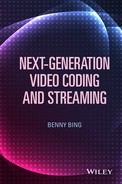PREFACE
TV remains the single most important and engaging source of information and entertainment. U.S. teenagers spend more than three times of their spare time watching TV than on social media. The global footprint of TV has been enhanced recently by online video, which includes online TV. U.S. consumers watch more movies online than on DVDs, Blu-ray discs and other physical video formats. This trend is driven by the flexibility of on-the-go mobile entertainment and the widespread adoption of video-capable smartphones and tablets. These personal devices have become ubiquitous with greatly expanded computing power and memory, improved displays, and network connectivity. The accelerated growth of video traffic on the Internet is expected to continue. However, supporting high-quality video delivery presents a significant challenge to Internet service providers due to the higher bandwidth demands compared to data and voice traffic.
This book describes next-generation video coding and streaming technologies with a comparative assessment of the strengths and weaknesses. Specific emphasis is placed on the H.265/HEVC video coding standard and adaptive bit rate video streaming. H.265/HEVC has been developed to meet the demands of emerging UHD video services and pervasive online video streaming. The commercial adoption of H.265/HEVC has started to gain traction since 2014. Invaluable insights into the coding efficiencies of the intracoded and intercoded frames are described in this book, including the impact of different types of video content and powerful feature sets such as the hierarchical block structure and new coding parameters. Adaptive streaming is a key enabling technology that can achieve smooth and reliable video delivery over heterogeneous wireline and wireless networks, as well as multiscreen personal devices. It provides autonomous bandwidth management and maintains quality of service even as link conditions and network congestion vary. This book provides an in-depth study on the practical performance of the popular adaptive streaming platforms and useful tips for streaming optimization. Innovative techniques related to aggregate adaptive stream bandwidth prediction, duplicate chunk suppression, and server-based adaptive streaming are also discussed.
I wish to thank Wiley's Publisher Dr. Simone Taylor, for her encouragement and patience in overseeing this book project. I also like to acknowledge my industry collaborators and former students who have been generous in sharing many useful comments. The book includes over 220 illustrative figures and over 110 homework problems containing interesting ideas and extensions to key concepts. Powerpoint slides and solutions to the homework problems are available to instructors who adopt the book for a course. Please feel free to send your comments and questions to [email protected].
Benny Bing
